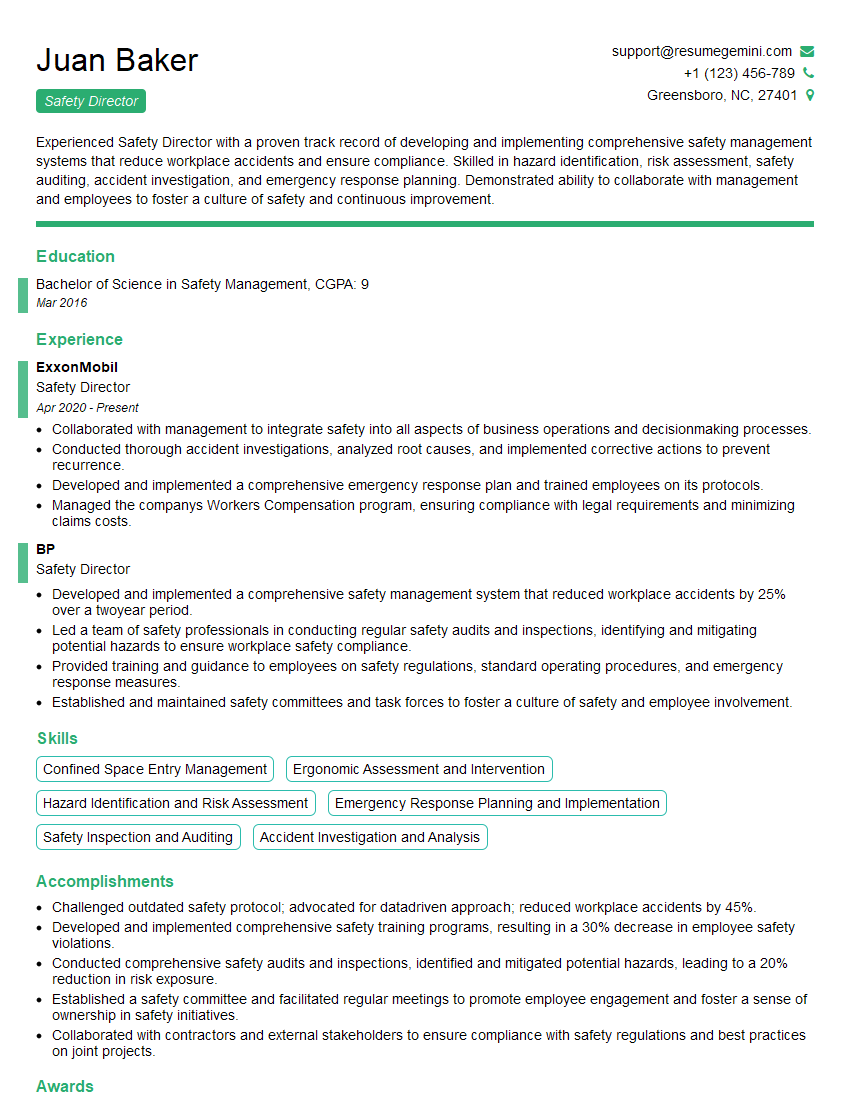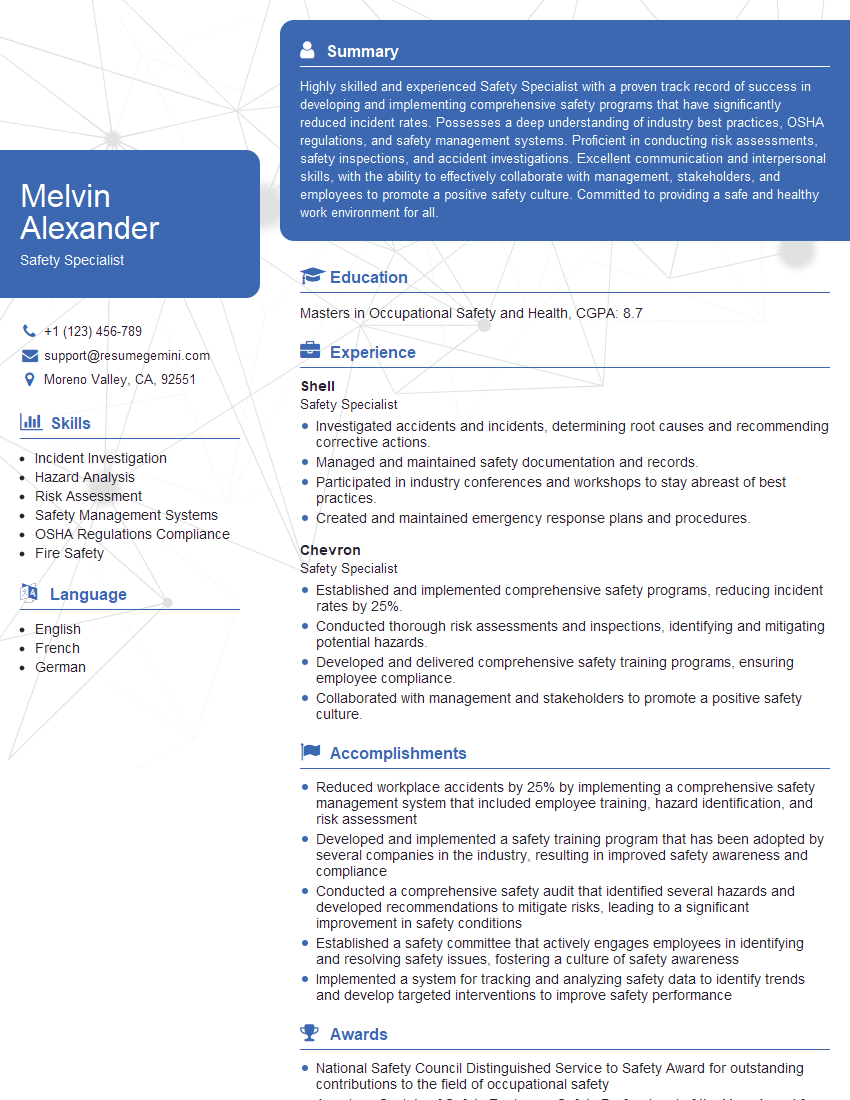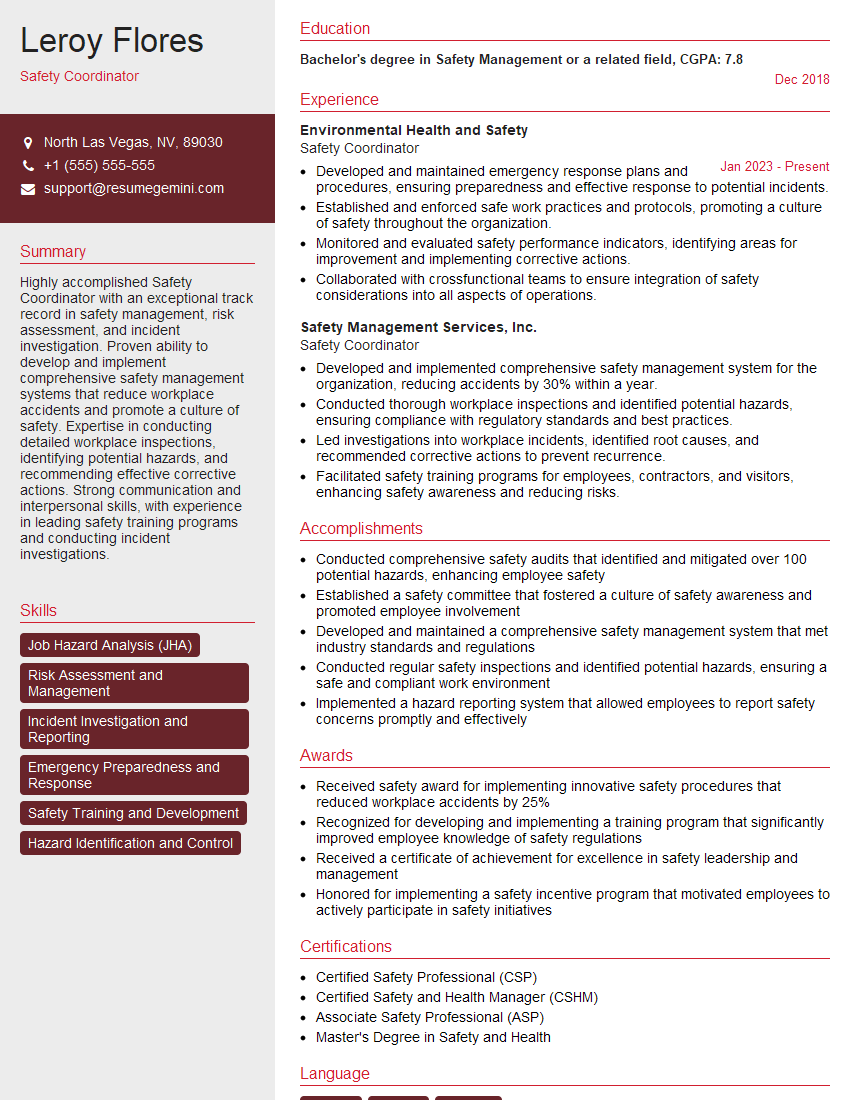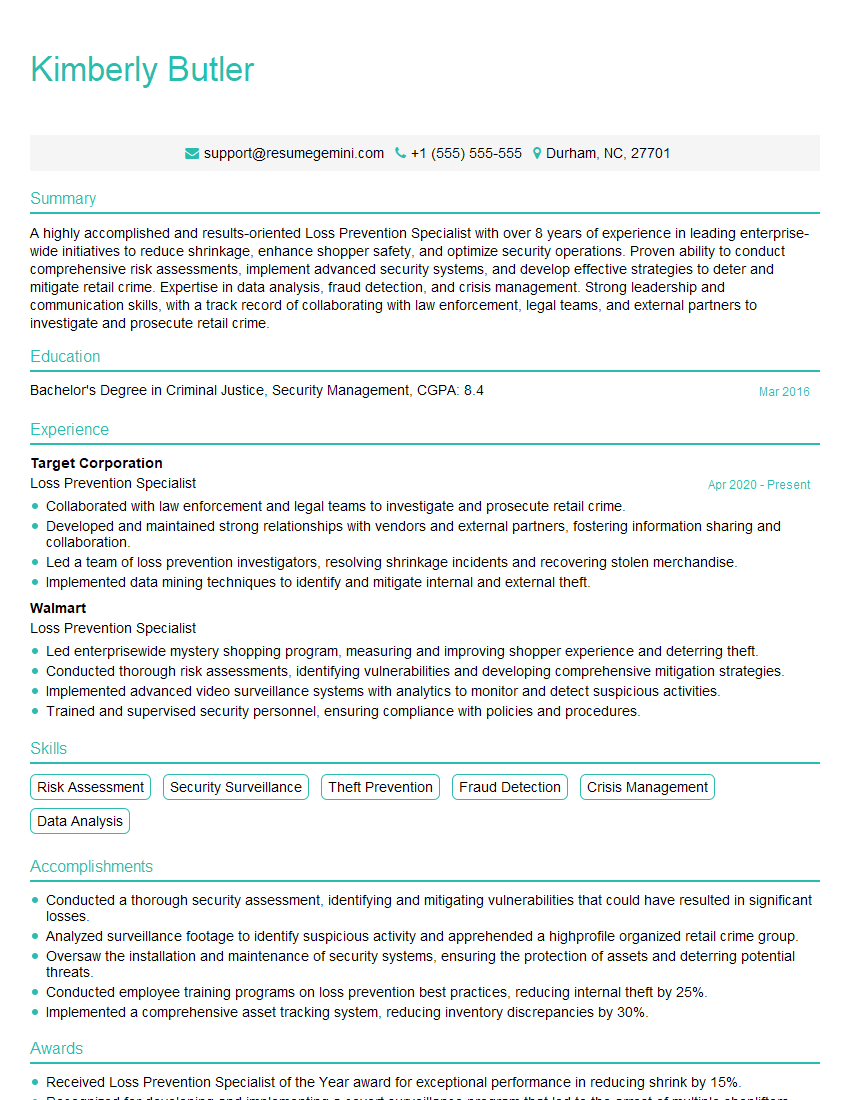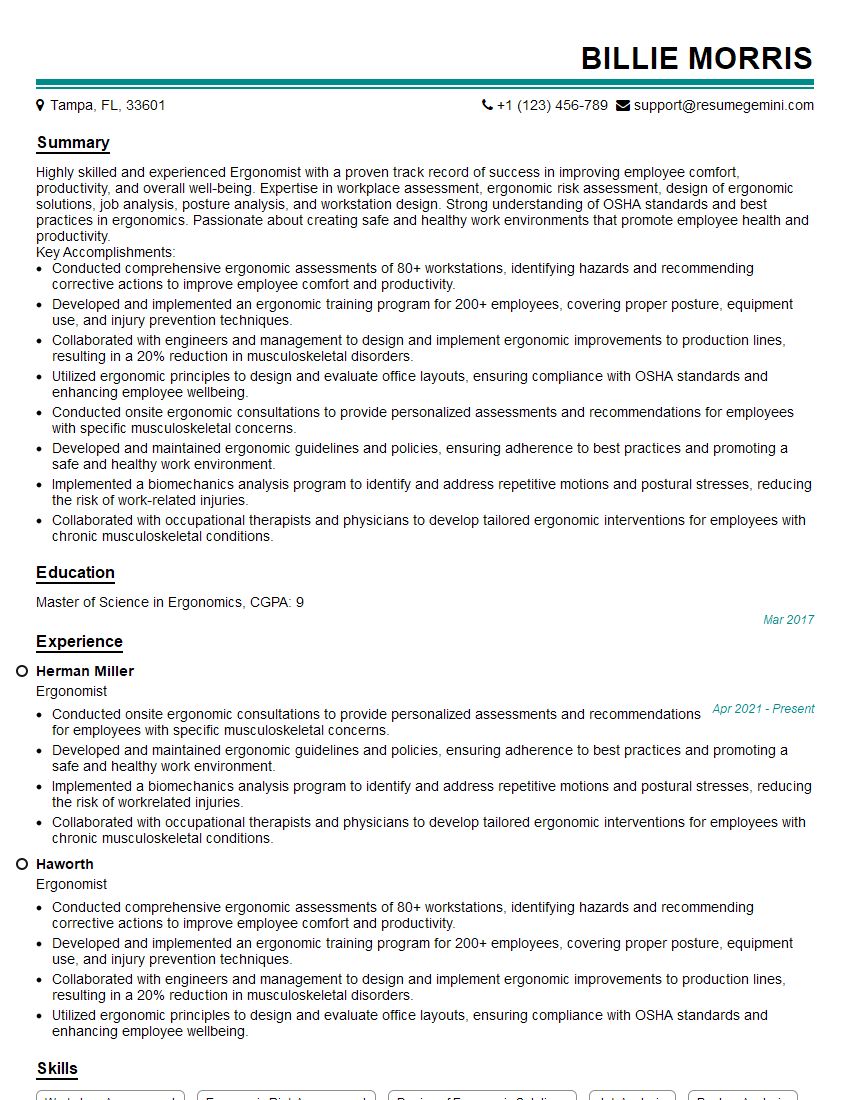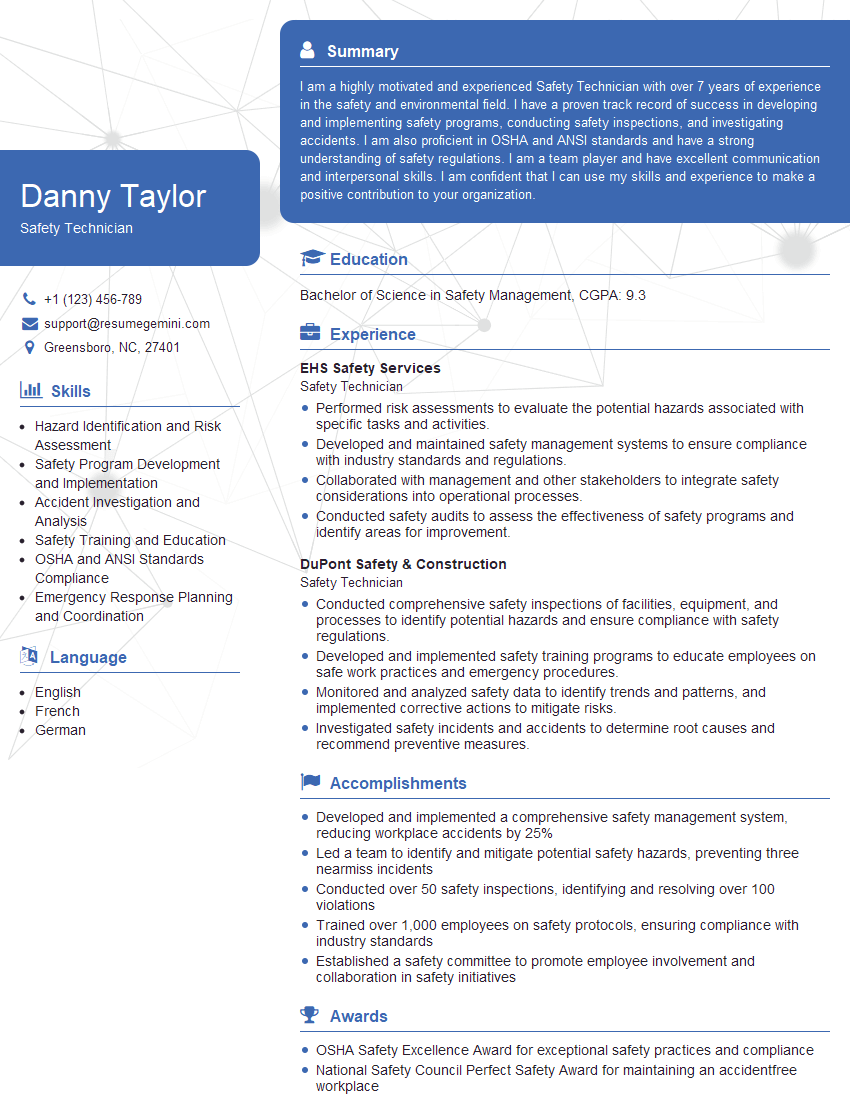Unlock your full potential by mastering the most common Safety and OSHA Regulations Compliance interview questions. This blog offers a deep dive into the critical topics, ensuring you’re not only prepared to answer but to excel. With these insights, you’ll approach your interview with clarity and confidence.
Questions Asked in Safety and OSHA Regulations Compliance Interview
Q 1. Explain your understanding of OSHA’s General Duty Clause.
OSHA’s General Duty Clause, found in Section 5(a)(1) of the Occupational Safety and Health Act, is the cornerstone of workplace safety. It’s a catch-all provision stating that employers must furnish to each of their employees a workplace free from recognized hazards that are causing or are likely to cause death or serious physical harm. Think of it as the overarching principle – if a specific OSHA standard doesn’t cover a hazard, this clause still holds employers accountable. For example, if a new chemical is introduced without adequate safety data sheets or training, the employer could be cited under the General Duty Clause, even if no specific standard directly addresses that particular chemical. It’s the employer’s responsibility to proactively identify and mitigate hazards, not just react to existing standards.
The clause requires a three-part demonstration by OSHA for a violation: (1) the hazard was recognized in the industry; (2) the hazard was likely to cause death or serious physical harm; and (3) feasible means to abate the hazard existed. This means OSHA needs to prove not only that a hazard existed, but also that the industry knew about it and that the employer could have reasonably prevented it. This clause provides crucial flexibility, adapting to emerging technologies and hazards not covered by specific standards.
Q 2. Describe your experience with OSHA Form 300.
OSHA Form 300 is the log of work-related injuries and illnesses. My experience with it includes not only completing the form accurately and comprehensively, but also ensuring its proper maintenance and accessibility for OSHA inspections. This involves meticulously recording every work-related injury and illness, regardless of severity, using the appropriate codes and descriptions. I’ve been involved in developing and implementing systems to ensure accurate and timely reporting, including regular reviews of the log to identify trends and potential hazards. This goes beyond simply filling out the form; it involves analyzing the data to proactively address safety concerns, preventing future incidents. For example, a high number of back injuries might indicate a need for improved lifting techniques or ergonomic assessments.
Furthermore, I understand the importance of maintaining the Form 300 records confidentially for three years, ensuring employee privacy while still allowing authorized personnel access. I’ve also been involved in the preparation for OSHA inspections, including ensuring that all necessary documentation, including Form 300, is readily available and organized for efficient review.
Q 3. How would you conduct a workplace safety audit?
Conducting a workplace safety audit is a systematic process. I begin with a thorough planning phase, identifying the scope of the audit (specific areas, departments, or processes) and establishing a timeline. Then, I utilize a combination of methods, including walkthroughs, interviews with employees at all levels, and document reviews (safety data sheets, training records, incident reports). During the walkthroughs, I visually inspect the workplace for hazards – looking for things like tripping hazards, electrical hazards, improper storage of materials, and unsafe machinery. Interviews are crucial for gathering firsthand accounts of safety concerns and identifying potential hazards that might not be immediately obvious. Document review helps to verify compliance with procedures and identify any gaps in documentation.
Once the data is collected, I analyze the findings, classifying hazards by severity and likelihood of occurrence. I then prepare a comprehensive report detailing the identified hazards, their severity levels, recommendations for corrective actions, and a prioritized timeline for implementation. The report includes both immediate actions to address critical hazards and longer-term recommendations for improving the overall safety management system. Following up on the implementation of recommendations is a key component to ensuring the effectiveness of the audit.
Q 4. What are the key elements of a comprehensive safety program?
A comprehensive safety program is multifaceted. It’s not just about having rules; it’s about fostering a safety culture. Key elements include:
- Management Commitment: Top-down support and resources are essential. Leaders must champion safety and visibly demonstrate their commitment.
- Hazard Identification and Assessment: Regularly identifying and assessing hazards using methods like Job Safety Analyses (JSAs) and hazard surveys.
- Hazard Control: Implementing the hierarchy of controls (elimination, substitution, engineering controls, administrative controls, PPE).
- Training and Education: Providing employees with the necessary knowledge and skills to work safely.
- Emergency Response Plan: Having a well-defined plan for responding to accidents and emergencies, including drills and regular reviews.
- Incident Investigation and Reporting: Thoroughly investigating incidents to identify root causes and prevent recurrence. This involves documenting and analyzing incidents, taking corrective actions, and reporting to OSHA as required.
- Recordkeeping: Maintaining accurate records of safety training, inspections, incidents, and corrective actions.
- Communication: Open communication channels are vital for ensuring employees feel comfortable reporting hazards and concerns.
The effectiveness of the program is regularly evaluated through safety audits and key performance indicators (KPIs), such as injury rates. It’s a continuous improvement process, not a one-time implementation.
Q 5. Explain the hierarchy of hazard controls.
The hierarchy of hazard controls prioritizes the most effective methods for eliminating or reducing hazards. The order is:
- Elimination: Completely removing the hazard. For example, removing a hazardous chemical from the process altogether.
- Substitution: Replacing the hazard with a less hazardous alternative. For example, substituting a toxic solvent with a less toxic one.
- Engineering Controls: Implementing physical changes to the workplace to reduce exposure to hazards. Examples include installing machine guards, ventilation systems, or improved lighting.
- Administrative Controls: Changes to work practices, procedures, or policies to minimize exposure. Examples include implementing work rotation schedules, providing more breaks, or improving training.
- Personal Protective Equipment (PPE): Providing workers with protective gear such as safety glasses, gloves, or respirators. This is the last resort and should only be used when other controls are not feasible or effective.
The hierarchy emphasizes the most effective and protective measures first, progressing to less effective methods only when necessary. This ensures that the safest possible working environment is created.
Q 6. How do you identify and assess workplace hazards?
Identifying and assessing workplace hazards requires a multi-pronged approach. I use a combination of methods, including:
- Walkthrough Inspections: Regularly inspecting the workplace to identify physical hazards.
- Job Safety Analyses (JSAs): Systematically examining each task to identify potential hazards and control measures.
- Incident Investigations: Thoroughly investigating accidents and near misses to determine root causes.
- Employee Input: Encouraging employees to report hazards and concerns.
- Data Analysis: Analyzing injury and illness data to identify trends and patterns.
- Regulatory Compliance Reviews: Ensuring compliance with applicable OSHA standards and other regulations.
Once hazards are identified, I assess their severity and likelihood of occurrence using a risk matrix. This allows me to prioritize corrective actions based on the level of risk posed by each hazard. This data informs the development of effective control measures and communicates the relative priority of risk reduction efforts.
Q 7. Describe your experience with lockout/tagout procedures.
My experience with lockout/tagout (LOTO) procedures is extensive, encompassing the development, implementation, and training aspects. I understand that LOTO is a critical safety procedure designed to prevent the unexpected energization or startup of equipment during servicing and maintenance. This involves completely de-energizing equipment and applying a lockout device (lock) and a tagout device (tag) to visually indicate that the equipment is locked out and should not be operated.
I’ve been involved in developing and implementing LOTO programs that comply with OSHA 29 CFR 1470. This includes conducting thorough energy assessments to identify all potential energy sources, developing detailed procedures for each piece of equipment, providing comprehensive training to all authorized employees, and regularly auditing the program’s effectiveness to ensure compliance and identify any deficiencies. The training includes hands-on practice with the equipment and procedures, ensuring that employees understand the critical importance of LOTO and can properly perform the steps involved. Regular audits and drills help keep the LOTO process in practice and ensure employees remain confident and competent in their LOTO responsibilities, mitigating the risk of serious injury or death.
Q 8. How do you investigate and report workplace accidents?
Investigating workplace accidents requires a systematic approach to identify root causes and prevent recurrence. My process begins immediately after an incident with securing the scene to prevent further harm. Then, I follow a structured investigation, including:
- Gathering Information: This involves interviewing witnesses, the injured employee (if possible), and supervisors. I review any relevant documentation, such as safety reports, maintenance logs, and training records.
- Analyzing the Incident: I use techniques like fault tree analysis or the five whys to determine the underlying causes. This goes beyond simply identifying what happened to uncover why it happened. For example, a fall from a ladder might not just be a ladder failure, but also a lack of proper training on ladder safety.
- Documenting Findings: I meticulously document all findings, including photos, witness statements, and my analysis. This documentation forms the basis of the accident report.
- Reporting: The report is submitted to the appropriate authorities, including OSHA if required (depending on the severity and nature of the incident). It outlines the incident, the investigation findings, and recommended corrective actions to prevent future occurrences.
For example, in a previous role, I investigated a near-miss involving a forklift. Through interviews and analysis, I found that the operator lacked sufficient training on operating the forklift in tight spaces. The resulting corrective action was enhanced training and a review of the workplace layout.
Q 9. Explain your understanding of personal protective equipment (PPE).
Personal Protective Equipment (PPE) is crucial for protecting workers from workplace hazards. It’s the last line of defense against risks that cannot be eliminated through engineering or administrative controls. OSHA emphasizes a hierarchy of controls, placing PPE last after hazard elimination, substitution, engineering controls, and administrative controls.
My understanding encompasses:
- Hazard Assessment: Appropriate PPE selection is based on a thorough hazard assessment to determine the specific risks present in a given task. Different tasks require different PPE.
- Proper Selection: Choosing the right PPE is critical; a hard hat might protect against falling objects, but not against electrical hazards. The correct PPE should be selected based on the identified hazards.
- Training and Fit Testing: Workers must be trained on how to properly use and maintain their PPE. Fit testing is often required to ensure the equipment fits correctly and provides adequate protection. For respirators, this is mandatory.
- Maintenance and Inspection: Regular inspection and maintenance of PPE are essential. Damaged or worn-out PPE should be immediately replaced.
- Compliance with Standards: All PPE must meet relevant OSHA standards and ANSI standards where applicable.
For instance, in a construction setting, PPE might include hard hats, safety glasses, high-visibility vests, steel-toe boots, and hearing protection, depending on the specific tasks.
Q 10. How do you ensure compliance with OSHA’s recordkeeping requirements?
OSHA’s recordkeeping requirements are designed to track workplace injuries and illnesses to identify trends and prevent future incidents. Compliance involves:
- Maintaining OSHA 300 Log: This log records all work-related injuries and illnesses meeting OSHA’s criteria. This log must be updated regularly and kept for 5 years.
- OSHA 300A Summary: This summary is posted annually from February 1 to April 30. It’s a concise version of the 300 log, summarizing the year’s data.
- OSHA 301 Incident Report: For each recordable injury or illness, a more detailed incident report (Form 301) is completed, providing more information about the incident.
- Accurate Recordkeeping: Maintaining accurate and complete records is paramount. Inaccuracies can lead to penalties.
- Electronic Recordkeeping: OSHA allows for electronic recordkeeping, provided the system meets specified requirements.
I utilize software specifically designed for OSHA recordkeeping to ensure accuracy and compliance. This software often includes features for generating reports and analyzing trends to identify areas needing improvement.
Q 11. What are your strategies for promoting a strong safety culture?
Building a strong safety culture is essential for a safe workplace. My strategies include:
- Leadership Commitment: Safety must be prioritized by leadership, from the top down. This shows employees that safety is a core value.
- Employee Involvement: Actively involve employees in safety initiatives. This includes safety committees, regular safety meetings, and encouraging employees to report hazards.
- Effective Communication: Regular communication about safety issues is key. This can be done through newsletters, toolbox talks, and other methods.
- Training and Education: Provide comprehensive safety training to all employees. Training should be tailored to the specific hazards present in the workplace.
- Recognition and Rewards: Recognize and reward employees for their contributions to safety. This can reinforce positive safety behaviors.
- Incident Investigation and Corrective Actions: Thoroughly investigate all incidents to determine root causes and implement effective corrective actions.
For example, I’ve implemented a system of peer-to-peer safety observations where employees can provide positive feedback and identify potential hazards, fostering a culture of shared responsibility.
Q 12. How do you handle employee safety concerns and complaints?
Employee safety concerns and complaints must be addressed promptly and confidentially. My approach includes:
- Establishing a Reporting System: Create a clear and accessible system for employees to report safety concerns, ensuring anonymity where appropriate.
- Prompt Investigation: Investigate all reported concerns thoroughly and objectively.
- Effective Communication: Communicate the results of the investigation and any corrective actions taken to the employee(s) involved.
- Addressing Root Causes: Focus on addressing the root causes of the problem, not just the symptoms.
- Follow-up: Follow up with the employee to ensure their concerns have been adequately addressed.
In one instance, an employee reported concerns about inadequate lighting in a particular work area. Following an investigation, we implemented improved lighting, directly addressing the safety risk.
Q 13. Describe your experience with developing and delivering safety training.
I have extensive experience developing and delivering safety training programs. My approach is to:
- Needs Assessment: Conduct a thorough needs assessment to identify the specific training requirements of the workforce.
- Curriculum Development: Develop engaging and interactive training materials, tailored to the needs of the employees and the specific hazards of the workplace. I use a variety of methods including presentations, videos, hands-on activities, and simulations.
- Delivery Methods: Use a variety of delivery methods, including classroom training, online modules, and on-the-job training, to cater to different learning styles.
- Evaluation: Evaluate the effectiveness of the training through pre- and post-tests, and by observing employee performance in the workplace.
- Documentation: Maintain detailed records of training attendance and completion.
For example, I once developed a comprehensive lockout/tagout training program for a manufacturing facility, resulting in a significant reduction in near misses involving machinery.
Q 14. What are your strategies for reducing workplace injuries and illnesses?
Reducing workplace injuries and illnesses requires a multi-faceted approach. My strategies include:
- Hazard Identification and Control: Proactively identify and control hazards through regular safety inspections and risk assessments. This includes implementing engineering controls, administrative controls, and, as a last resort, PPE.
- Employee Training and Education: Provide comprehensive safety training and education to all employees.
- Incident Investigation and Analysis: Thoroughly investigate all incidents to identify root causes and implement corrective actions to prevent recurrence.
- Promoting a Positive Safety Culture: Foster a positive safety culture where employees feel empowered to report hazards and participate in safety initiatives.
- Regular Safety Audits and Inspections: Conduct regular safety audits and inspections to identify potential hazards and ensure compliance with safety regulations.
- Data Analysis and Trend Monitoring: Analyze safety data to identify trends and target areas needing improvement. This data-driven approach allows for proactive interventions.
By combining these strategies, we can create a safer workplace, protecting employees and improving overall productivity.
Q 15. How familiar are you with OSHA’s regulations on hazard communication?
OSHA’s Hazard Communication Standard (HazCom) is crucial for workplace safety. It mandates that employers inform employees about the dangers of hazardous chemicals in the workplace. This involves creating and maintaining Safety Data Sheets (SDS) for each hazardous chemical and providing employees with clear and accessible training on how to handle those chemicals safely. I’m intimately familiar with all aspects of HazCom, including the proper labeling of containers, the development of comprehensive written hazard communication programs, and the provision of employee training that complies with OSHA’s standards.
For example, I’ve implemented HazCom programs in manufacturing facilities, ensuring proper labeling of all chemical containers with signal words (like Danger or Warning), hazard pictograms, and precautionary statements. I’ve also developed and delivered training sessions covering the interpretation of SDSs, the proper use of personal protective equipment (PPE), and emergency procedures in the event of a chemical spill. My experience ensures complete compliance and a safe working environment.
Career Expert Tips:
- Ace those interviews! Prepare effectively by reviewing the Top 50 Most Common Interview Questions on ResumeGemini.
- Navigate your job search with confidence! Explore a wide range of Career Tips on ResumeGemini. Learn about common challenges and recommendations to overcome them.
- Craft the perfect resume! Master the Art of Resume Writing with ResumeGemini’s guide. Showcase your unique qualifications and achievements effectively.
- Don’t miss out on holiday savings! Build your dream resume with ResumeGemini’s ATS optimized templates.
Q 16. Explain your experience with conducting safety inspections.
Conducting safety inspections is a systematic process to identify and mitigate hazards. My approach involves a thorough walkthrough of the facility, observing work practices, inspecting equipment, and examining the work environment for potential hazards. I use checklists tailored to the specific work area, noting any discrepancies from established safety procedures or OSHA regulations. I document all findings with photographs and detailed descriptions, prioritizing hazards based on severity and probability of occurrence.
For instance, during an inspection at a construction site, I noticed several workers weren’t using proper fall protection equipment. I immediately reported this to the site supervisor, and we implemented corrective actions, including providing proper training and ensuring all workers had the necessary safety harnesses and fall arrest systems. My inspections always focus on preventing accidents before they happen.
Q 17. How do you manage safety risks associated with specific work tasks?
Managing safety risks associated with specific work tasks requires a proactive, multi-step approach. This begins with a thorough Job Hazard Analysis (JHA). A JHA identifies potential hazards and develops control measures to mitigate those risks. This includes engineering controls (e.g., machine guarding), administrative controls (e.g., work permits), and personal protective equipment (PPE). The process doesn’t end there; regular monitoring and evaluation are necessary to ensure the effectiveness of the implemented controls.
For example, when implementing a JHA for a task involving working at heights, we would identify potential hazards like falls, consider engineering controls like scaffolding with guardrails, implement administrative controls like work permits and supervision, and make sure workers are trained and equipped with appropriate harnesses and safety lines (PPE). This multi-faceted approach reduces risk significantly.
Q 18. How do you ensure compliance with OSHA’s emergency action plan requirements?
OSHA mandates that every workplace have a comprehensive Emergency Action Plan (EAP). My role in ensuring compliance involves developing and implementing an EAP that addresses all potential emergencies, including fire, chemical spills, and medical emergencies. The EAP includes procedures for evacuation, alarm systems, emergency response teams, and communication protocols. Regular training and drills are crucial to ensure that all employees are familiar with and understand the plan. The plan must be easily accessible to all employees, posted in prominent locations, and regularly reviewed and updated.
For example, I’ve developed EAPs that include detailed maps showing evacuation routes, designated assembly points, and the responsibilities of various emergency response team members. We conduct regular fire drills and other emergency response drills to ensure that the plan functions effectively and that employees know exactly what to do in the event of an emergency.
Q 19. Explain your understanding of OSHA’s requirements for confined space entry.
OSHA’s confined space entry regulations are very strict and designed to protect workers from serious hazards, including oxygen deficiency, toxic atmospheres, and engulfment. Before any entry, a permit-required confined space program must be developed and implemented. This involves conducting atmospheric monitoring, developing rescue plans, and ensuring that all entrants are properly trained and equipped with appropriate PPE. A qualified person must monitor atmospheric conditions continuously during entry, and a standby rescue team must be present.
I have extensive experience in developing and managing confined space entry programs. This involves everything from pre-entry assessments and atmospheric testing to the selection and training of authorized entrants and standby rescue personnel. Understanding and complying with OSHA’s regulations in this area is paramount to preventing fatalities and serious injuries.
Q 20. Describe your experience with developing and implementing safety policies.
Developing and implementing safety policies is a core part of my expertise. This involves a collaborative process that includes analyzing existing hazards, identifying potential risks, and establishing clear and concise safety policies that address these issues. These policies must be communicated effectively to all employees through training programs and readily available documentation. Regular review and updates are crucial to maintain relevance and effectiveness.
For example, I’ve developed safety policies covering topics such as lockout/tagout procedures, hazard communication, and personal protective equipment (PPE) use. These policies are not only written but also accompanied by training programs and regular audits to ensure consistent compliance and continuous improvement of the safety culture within the organization.
Q 21. How do you stay updated on changes in OSHA regulations?
Staying updated on changes in OSHA regulations requires ongoing vigilance. I subscribe to OSHA’s publications and regularly check their website for updates and new standards. I attend relevant safety conferences and training sessions to learn about best practices and emerging trends. I also network with other safety professionals to stay informed about changes in the field. Professional memberships in organizations like the American Society of Safety Professionals (ASSP) provide access to valuable resources and information.
Regularly reviewing and updating our safety programs based on the latest OSHA regulations is not just a matter of compliance; it’s a commitment to providing a continuously improving safe working environment. This proactive approach ensures that our safety protocols are always current and effective.
Q 22. How do you handle conflicts between productivity and safety?
The false dichotomy between productivity and safety is a pervasive challenge. It’s crucial to understand that prioritizing safety doesn’t inherently hinder productivity; rather, unsafe practices are ultimately far more costly and unproductive in the long run. My approach is based on a proactive, integrated system.
- Risk Assessment & Mitigation: Thorough risk assessments identify potential hazards and allow us to implement controls that eliminate or minimize risks before they impact productivity. For instance, if repetitive motions are causing strain injuries, we might invest in ergonomic workstations – a seemingly minor cost with significant returns in reduced lost-time injuries and improved employee morale and efficiency.
- Training and Empowerment: Well-trained employees are safer and more productive employees. Investing in regular safety training equips them to identify and report hazards, leading to a safer work environment and preventing costly incidents. This might involve training on specific equipment operation, lockout/tagout procedures, or hazard communication standards.
- Incentivizing Safe Practices: Implementing reward systems for safe work behaviors encourages employees to adopt and maintain safe practices. This could range from simple recognition programs to safety bonuses.
- Leading by Example: Management commitment to safety is paramount. Visible support and active participation from supervisors demonstrate the value of safety and influence employee behavior.
Ultimately, I advocate for a culture where safety is integrated into every aspect of the workflow, not an afterthought. This holistic approach proves that safety and productivity are mutually reinforcing, not conflicting, goals.
Q 23. How do you measure the effectiveness of your safety programs?
Measuring the effectiveness of safety programs requires a multi-faceted approach that goes beyond simply tracking the number of accidents. We need leading and lagging indicators.
- Lagging Indicators (reactive): These measure the results of safety efforts after an event has occurred. Examples include the number of recordable incidents (lost-time injuries, etc.), severity rate, and days away from work.
- Leading Indicators (proactive): These measure the effectiveness of preventative measures. They’re crucial in identifying potential problems before they result in accidents. Examples include the number of near misses reported, participation rates in safety training, completion rates of safety audits, and the effectiveness of safety inspections.
Data Analysis & Reporting: We use data collected from these indicators to track trends, identify areas needing improvement, and measure the overall effectiveness of our safety initiatives. Regular reports are generated and analyzed to inform management decisions and allocate resources effectively. For example, a consistent increase in near-miss reports for a specific task might indicate the need for enhanced training or a redesign of the workflow.
Employee Feedback: Regular employee surveys and feedback mechanisms are critical for understanding their perceptions of safety and identifying areas where improvements can be made. This participatory approach ensures the programs remain relevant and effective.
Q 24. Describe your experience with using safety software or databases.
I’ve extensive experience using various safety software and databases, including incident reporting systems, training management platforms, and risk assessment tools. For example, I have worked with OSHAcademy for regulatory updates and online training, and ISHN (Industrial Safety and Hygiene News) for industry best practices. We also utilize a custom-built database for tracking safety performance indicators (KPIs), near misses, and corrective actions. This database allows us to:
- Centralize Data: Easily access and manage all safety-related data in one location.
- Track Trends: Identify patterns and trends that might indicate potential hazards.
- Generate Reports: Create reports for management, regulatory agencies, and insurance companies.
- Automate Tasks: Streamline processes such as scheduling inspections, training, and follow-ups.
The software isn’t just about data; it’s about facilitating better decision-making, improving communication, and ultimately, creating a safer work environment. I’m proficient in using these tools to ensure compliance, analyze trends, and proactively prevent incidents.
Q 25. How do you ensure that safety procedures are followed consistently?
Ensuring consistent adherence to safety procedures requires a multi-pronged strategy that combines clear communication, effective training, robust monitoring, and reinforcement.
- Clear and Accessible Procedures: Safety procedures need to be clear, concise, and readily available to all employees in multiple formats (e.g., written instructions, videos, and interactive training modules). Using simple language and visuals ensures understanding regardless of language or literacy levels.
- Comprehensive Training: Initial and ongoing training is crucial to equip employees with the knowledge and skills to follow safety procedures correctly. Training should include hands-on practice and regular refresher courses to reinforce learning and address any changes in procedures or equipment.
- Regular Monitoring and Audits: Implementing a system of regular safety inspections and audits allows for early detection of non-compliance and ensures procedures are followed effectively. This includes both scheduled inspections and random spot checks.
- Feedback and Reinforcement: Positive reinforcement and timely feedback are vital for maintaining consistent compliance. Recognizing employees who follow safety procedures correctly and addressing instances of non-compliance promptly helps encourage safe practices.
- Accountability: Clearly defined roles and responsibilities are crucial. Knowing who is responsible for enforcing procedures and who to report to if a procedure is not being followed is essential.
In essence, it’s about building a safety culture where following procedures isn’t just expected, but seen as a shared responsibility that contributes to everyone’s well-being and the success of the organization.
Q 26. How do you address and resolve safety violations?
Addressing safety violations requires a fair, consistent, and corrective approach. My approach focuses on understanding the root cause, taking corrective action, and preventing recurrence.
- Investigation: A thorough investigation is conducted to determine the facts surrounding the violation, including the contributing factors and root causes. This often involves interviewing witnesses, reviewing documentation, and analyzing the work environment.
- Corrective Actions: Based on the investigation, appropriate corrective actions are implemented to address the violation and prevent future occurrences. This might include retraining, improving equipment, modifying procedures, or implementing engineering controls.
- Disciplinary Actions (if necessary): Depending on the severity of the violation and the employee’s history, disciplinary actions may be necessary. These should be fair, consistent, and proportionate to the offense, documented thoroughly, and in line with company policy and legal requirements.
- Documentation: Meticulous documentation is essential throughout the entire process, from the initial report to the corrective actions and follow-up.
- Follow-up: It is essential to monitor the effectiveness of corrective actions and ensure that the violation doesn’t recur. Regular follow-up inspections and monitoring are crucial.
The goal is not punishment, but learning and improvement. By focusing on root cause analysis and preventive measures, we aim to create a safer work environment for everyone.
Q 27. What are some common safety hazards in [industry-specific] work environments?
(Please specify the industry for a tailored response. However, I can offer some general examples applicable to many industries.)
Common safety hazards across many workplaces include:
- Slips, Trips, and Falls: These are among the most frequent causes of workplace accidents. Hazards include wet or oily floors, uneven surfaces, inadequate lighting, and cluttered walkways.
- Electrical Hazards: Improperly grounded equipment, exposed wires, and damaged electrical cords can lead to serious injury or fatalities.
- Machine Guarding: Failure to use or maintain proper machine guarding can result in injuries from moving parts.
- Hazardous Materials: Improper handling, storage, or disposal of hazardous materials can pose risks to workers’ health and safety. This includes chemicals, solvents, and biological agents.
- Ergonomic Hazards: Repetitive motions, awkward postures, and excessive force can lead to musculoskeletal disorders.
- Fire Hazards: Improper storage of flammable materials, lack of fire extinguishers, and inadequate fire safety training can significantly increase the risk of fire.
Specific hazards will vary significantly based on the industry. For example, a construction site will have different hazards than a manufacturing plant. Once you provide the specific industry, I can give more precise and detailed information.
Q 28. Describe a time you had to deal with a serious workplace accident; what was your role?
During my time at [Previous Company Name], we experienced a serious workplace accident involving a worker’s hand being caught in a machine. My role was crucial in managing the immediate aftermath and leading the investigation.
- Immediate Response: I immediately secured the area, ensuring the safety of other workers and preventing further incidents. I contacted emergency medical services and followed company protocols for reporting and documenting the incident.
- Accident Investigation: I led the accident investigation team, conducting thorough interviews with witnesses, reviewing machine maintenance logs, and examining the machine for any defects. We used root cause analysis techniques (like the 5 Whys) to identify the underlying causes of the accident.
- Corrective Actions: Based on the investigation’s findings, we implemented several corrective actions, including upgrading the machine’s safety guarding, implementing new lockout/tagout procedures, and providing additional training to employees on machine safety.
- Communication: I ensured clear and timely communication to the affected employee, their family, other employees, and relevant regulatory bodies.
- Reporting and Documentation: I prepared a comprehensive accident report for internal and external stakeholders, including OSHA if required. The report detailed the incident, root causes, corrective actions, and lessons learned.
This experience reinforced the importance of proactive safety measures, rigorous training, and thorough accident investigation in preventing future incidents. It also underscored the critical role of empathy and support for the affected worker and their family during a difficult time. The incident became a valuable learning opportunity, leading to significant improvements in our safety protocols and culture.
Key Topics to Learn for a Safety and OSHA Regulations Compliance Interview
- OSHA Standards: Understanding key OSHA standards relevant to your target industry (e.g., General Industry, Construction, Maritime). Focus on recognizing the hierarchy of controls and practical application.
- Hazard Identification and Risk Assessment: Mastering techniques for identifying potential hazards, assessing their risks, and implementing control measures (elimination, substitution, engineering controls, administrative controls, PPE).
- Incident Investigation and Reporting: Learn the process for investigating workplace incidents, documenting findings, and preparing reports compliant with OSHA regulations. Practice analyzing root causes and recommending preventative measures.
- Emergency Preparedness and Response: Familiarize yourself with emergency action plans, evacuation procedures, and the roles and responsibilities of safety personnel during emergencies. Understanding different types of emergencies and appropriate responses is crucial.
- Recordkeeping and Compliance: Understand OSHA recordkeeping requirements, including injury and illness logs, and the importance of maintaining accurate and complete records. Know how to interpret OSHA data and identify trends.
- Employee Training and Education: Learn how to develop and deliver effective safety training programs tailored to different employee roles and tasks. Understanding adult learning principles and effective training methodologies will be invaluable.
- Inspections and Audits: Develop your skills in conducting safety inspections and audits, identifying non-compliance issues, and recommending corrective actions. Understanding OSHA inspection procedures will be advantageous.
- Relevant Legislation and Regulations: Stay updated on any changes or updates to OSHA regulations and related legislation impacting your field. Demonstrate a commitment to continuous learning.
Next Steps
Mastering Safety and OSHA Regulations Compliance is crucial for career advancement in this vital field. Demonstrating a strong understanding of these regulations will significantly enhance your job prospects and open doors to leadership roles. To maximize your chances of securing your dream position, focus on building a strong, ATS-friendly resume that highlights your skills and experience. ResumeGemini is a trusted resource that can help you craft a compelling resume tailored to your specific experience and target roles. Examples of resumes tailored to Safety and OSHA Regulations Compliance are available to provide inspiration and guidance. Take advantage of these resources to showcase your expertise and land your ideal job.
Explore more articles
Users Rating of Our Blogs
Share Your Experience
We value your feedback! Please rate our content and share your thoughts (optional).
What Readers Say About Our Blog
Hi, I have something for you and recorded a quick Loom video to show the kind of value I can bring to you.
Even if we don’t work together, I’m confident you’ll take away something valuable and learn a few new ideas.
Here’s the link: https://bit.ly/loom-video-daniel
Would love your thoughts after watching!
– Daniel
This was kind of a unique content I found around the specialized skills. Very helpful questions and good detailed answers.
Very Helpful blog, thank you Interviewgemini team.

